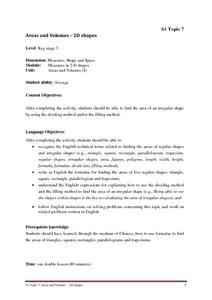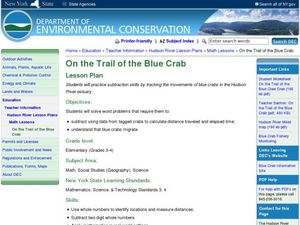Curated OER
Making/Building Kites
Young scholars explore kite making. In this cross curriculum fine arts and ancient Chinese history lesson, students activate prior knowledge about how kites were used in ancient Chinese culture. Young scholars sketch an...
Curated OER
Count the Stars
Students research information about China and its languages and counting systems. They identify Chinese characters for numeral from one to ten and then create a counting tool to assess Chinese numerals and represent the Chinese culture.
Curated OER
A Turkey for Thanksgiving - Lesson #2
Second graders investigate realistic fiction, holiday celebrations, making tally charts. For this multi-disciplinary lesson, 2nd graders listen to a story about Thanksgiving and one about the Chinese New Year to develop an understanding...
Scholastic
Calligraphy Minibook
Engage young learners in practicing their counting skills while teaching them about the Japanese writing system with this printable book. Using the included key that shows the kanji characters for the numbers 1-10, children...
Government of Hong Kong
Areas and Volumes - 2D Shapes
Unfortunately for young mathematicians, the world isn't made entirely of parallelograms, triangles, and trapezoids. After first learning the area formulas for these common shapes, students apply this new knowledge to...
Curated OER
Symmetry with Shapes
Students analyze a symmetrical stamp design with an equal balance of light and dark to create a pattern in succession. In this shape design lesson, students review concepts of sign, symbol and language across cultures. Students analyze...
Curated OER
Big Boats Up The River
Using boats along in the Port of Albany as the focus, learners practice adding single-digit numbers and interpreting data. This lesson comes with the worksheets, resource links, and other materials to make it a worthwhile experience.
Curated OER
Different Ways to Count
Fourth graders investigate various number systems and ways of counting. In this various number systems and ways of counting lesson, 4th graders discuss number systems from around the world. Students practice counting using...
Curated OER
Cultural Calendar
Young scholars design their own cultural calendar. In this calendar making lesson, students decide on a culture for a calendar theme and discuss how calendars differ from the US calendar. Young scholars create their own...
Curated OER
Out to Lunch
Sixth graders create a menu. In this math lesson, 6th graders use mean, median and mode to determine the prices for the typical cost of an appetizer, entree, kid's meal, drinks and dessert. Students write a number sentence to show how...
Curated OER
Responsibilities
Students identify different responsibilities they have at home and at school. In this responsibilities lesson plan, students identify the responsibilities they need to follow through on and what happens when they don't. They put...
Curated OER
Tens! Hundreds! Thousands!!! of Tons
Fifth graders take a close look at the types of ships that travel through the Hudson River Valley on the Hudson River. They utilize worksheets embedded in the plan in order to answer questions about exactly what is being shipped, and how...
Curated OER
On the Trail of the Blue Crab
Third graders read the article "Blue Claw," discuss crab migration, and look at a map of the Hudson River. They complete a worksheet where they must use subtraction to determine the distance migrating crabs travel.Web links, article, and...
Curated OER
The Hudson's Ups and Downs
Fifth graders practice interpreting line graphs of the Hudson River water levels to assess the tides and tidal cycles in the estuary. They explore how weather can affect water levels and tides and observe that high tides and low tides...
Curated OER
Finding the Salt Front
Students discuss definitions of estuary, salinity, and the salt front. They listen as the teacher explains the Hudson River Miles and ways the upriver and downriver sections relate to the north and south. Students graph the salt front...
Alabama Learning Exchange
Alex: Tan Ii
The Chinese character mark for Tan II (pronounced she-tow-bah) is the second of two lessons to introduce first grade students to geometry using tangrams. This instructional activity incorporates history, math, and language arts. In this...
Alabama Learning Exchange
Alex: "Tan"
The Chinese character mark formerly known as "Tan" is the first of two lessons to introduce first grade students to geometry using tangrams. This lesson plan incorporates history, math, and language arts. In this lesson plan students...
















